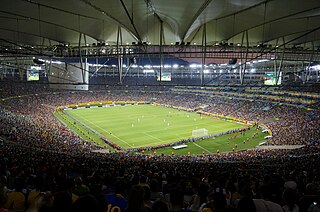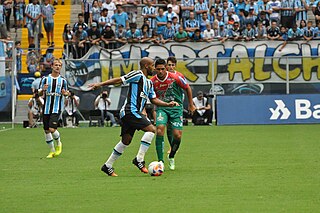Structure
There are two simultaneous and independent functioning pyramids in Brazil's football, the national pyramid and the states pyramids.
While the national competitions are organized by CBF, the state championships are organized by the respective football federations of each state (for example, the Campeonato Pernambucano is organized by the Pernambuco Football Federation).
The national pyramid competitions start in May and end in December. The state pyramids have varying durations and schedules in each state. In states with clubs competing in the national first and second divisions, the state championships run from January/February to April/May.
Most states have at least one secondary tournament, involving smaller clubs not in the top two leagues of the national championship. These lesser championships runs from July to December. Besides the trophy, it may award the winner(s) places in the main tournament or in the Brazilian Cup next year.
Smaller states, whose clubs do not take part in national competitions have longer competitions, usually running during the "winter" months: April to October.
National league
In the national pyramid, there are four leagues, the Série A, Série B, the Série C and the Série D. The Série A, Série B and Série C currently consist of 20 teams each. Série D was contested by 40 teams, expanded to 68 in 2016. Série A and Série B are contested in a double-round-robin format by all clubs; Série C and Série D have regional groups. Each year, the four worst placed clubs in the Série A are relegated to the Série B and the four top placed clubs in the Série B are promoted to Série A. This relation of four promoted and four relegated is the same for the other levels.
The clubs competing in the Série D are the bottom four from last season's Série C and the best placed state championship clubs from the previous season which are not competing in the Série A, B or C. Clubs that are successful in their state leagues can rise higher in the pyramid, be promoted to the Série D, and eventually to higher levels. Some state federations organize special competitions with the purpose of qualifying teams to the Série D.
As a result of the rules detailed above, it is possible (and not unheard of) for a minor state championship club to rise to the Série A, and become successful in the competition. To achieve this, a club must qualify in the state championship and, later, qualify in Séries D, C and B. Examples of clubs that went all the way up from the least state league until Série A are: Paraná Clube (founded in 1989, played Série A in 1993), São Caetano (founded in 1989, played Série A in 2000 and finished runner-up), Brasiliense (founded in 2000, played Série A in 2005), Grêmio Barueri (founded in 1989, played Série A in 2009) and Ipatinga (founded 1998, to play Série A in 2008). None of them are in 2015 Série A, but Paraná and São Caetano had a relative success in Série A for a while. Brasiliense and Ipatinga, however, never played a second year in this competition, being quickly relegated to Série B. Grêmio Barueri, for its part, only lasted in the first level for two years, before being relegated. The latter three teams eventually participated in the Série D in 2014, failing on achieving promotion.
The reverse is also possible: a club from Série A can eventually be relegated to the very least state league. A recent example is the rich in history América-MG (founded in 1912, relegated from Série A in 2001, to Série C in 2005 and to state second division in 2007). América played in the Série C in 2008 and 2009, avoiding the Série D. The club is back to National competitions and to its state first division, reaching Série A in 2011, although relegated to Série B in 2012. Currently, at least seven clubs (Fluminense, Náutico, Fortaleza, Vitória, Bahia, Guarani and América-MG) have been relegated to Série C and successfully reappeared in Série A. Santa Cruz, a Série A club in 2006, fell to Série D in 2010, but in 2016 is back to the top flight. Other clubs formerly in Série A, that were relegated to Séries C, D and below have not so far recovered their strength. For example, America (as of 2020, only playing in the state league), Remo (as of 2020, in the Série C), Juventude (as of 2020, in the Série B), América de Natal (as of 2020, in the Série D), Guarani (as of 2020, in the Série B) and Paysandu (as of 2020, in the Série C).
Since the national and state pyramids are independent a team can be in a national division and also be in a lower division in the state league in the same season. In 2018, Oeste played both the national Série B and the São Paulo state Série A2, the São Paulo state league second level.
State leagues
In the state pyramid, which consists of several independent state championships, the participating clubs, which also include Série A, Série B and Série C clubs, are limited to their own states (however, there are some minor exceptions, like in the Campeonato Brasiliense, where Unaí from Minas Gerais, and Luziânia and Bosque Formosa Esporte Clube from Goiás also compete, due to their proximity to Brasília, the capital of the Brazilian Federal District. [1] The leagues are usually divided in two, three or four levels. The number of clubs per level, as well as the number of levels, are different in each state. For example, in São Paulo there are 16 clubs in the first level, but in Minas Gerais there are 12, and in Rondônia there are just eight clubs. Also, the number of promoted and relegated clubs are different from one state to the other. Since 2009, the best placed clubs in the state leagues not already qualified for Série A, B, or C qualify for the Série D.
State championships may include obscure formats or experiment with proposed innovations in rules. As the Série A, Série B and Série C clubs usually have to be seeded to avoid fixture congestion, some rules adopted may be quite unfair. In the 2008 Campeonato Carioca, the big four (Botafogo, Flamengo, Fluminense and Vasco da Gama) always played home against the other participating clubs. [2]





